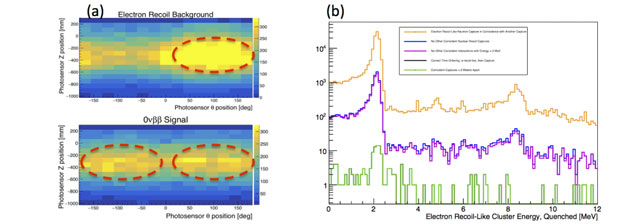Michael Heffner (15-ERD-014)
Project Description
Several of the biggest questions in physics can be answered by studying one of the smallest known particles, the neutrino. Despite the huge advances made in understanding these elusive particles, key questions remain. For example, we do not know the mass ordering or the value of neutrino masses or whether the neutrino is its own antiparticle. We have only just begun to test the three-neutrino-flavor paradigm in neutrino oscillation measurements and cosmological data analysis. Our objective is to address these questions through LLNL's Next Enriched Xenon Observatory (nEXO) and Oak Ridge National Laboratory's Precision Reactor Oscillation and Spectrum (PROSPECT) experiments. The nEXO experiment is a proposed 5-ton enriched xenon time-projection chamber that will search for the exceptionally rare and difficult-to-measure neutrinoless double-beta decay. The PROSPECT experiment will probe neutrino oscillations at the shortest-ever length scale, to address the many experimental anomalies that suggest the existence of a fourth neutrino flavor. First, we will work to improve background rejection, which is of critical importance to both experiments because the signals of interest are rare. Second, we will develop calibration methods to efficiently and precisely map detector energy and position response, because identifying the subtle imprint of neutrino oscillations in the PROSPECT experiment will require an exquisite understanding of those parameters. Third, we will establish the optimal method to perform a large-scale neutrinoless double-beta decay experiment, focusing on the time-projection chamber approach central to nEXO.
To study optical signals, we will develop an optical simulation framework with significantly greater computational efficiency that can be used for different aspects of both the nEXO and PROSPECT experiments. For nEXO, we will use this capability to exhaustively study the Cherenkov and xenon scintillation emissions from neutrinoless double-beta decay signals and Compton-scatter background electrons, and thus establish background discrimination metrics based upon differences in how these event classes partition energy among electrons and the directionality of Cherenkov emissions. For PROSPECT, we will focus on optimizing the pulse shape discrimination performance of the scintillator segments that will comprise the antineutrino detector. We will also develop a precise calibration technique for PROSPECT. The approach will use time-coincident detection of multiple Compton scatters of a high-energy gamma ray. Using the position reconstruction capability of the segments, observed event topologies can be used to determine expected Compton electron energies. Comparison of expected and observed deposition amplitudes will allow the segment response to be mapped as a function of position. Finally, we will determine if the background decay contamination of a large-scale xenon detector, such as proposed as part of the nEXO experiment, is inherently manageable or if dopants for xenon or alternatives to xenon should be pursued.
Mission Relevance
Probing neutrinoless double-beta decay and neutrino oscillations at short length scales directly addresses issues of Laboratory core competencies in nuclear, chemical, and isotopic science and technology, as well as radiation detection systems. We fully expect that the successful completion of our work will play a central role in the full realization of the nEXO and PROSPECT projects. The Laboratory will therefore have the opportunity to lead world-class, high-profile, and high-priority scientific discovery experiments.
FY16 Accomplishments and Results
In FY16 we (1) studied the use of Cherenkov light for the detection of neutrinoless double-beta decay in the nEXO detector (see figure); (2) completed simulation of the preliminary design of primary shielding for the cryostat; (3) completed design of the high-voltage test stand vessels; (4) used the PROSPECT simulation framework to study important elements of the proposed antineutrino detector design, specifically the optical collection performance as a function of several critical parameters such as photomultiplier tube and segment size; and (5) compared studies with prototype data and determined that the agreement is good.
Publications and Presentations
- Ashenfelter, J., et al., "Background radiation measurements at high power research reactors." Nucl. Instrum. Meth. A806, 401 (2016). LLNL-JRNL-669986. http://dx.doi.org/10.1016/j.nima.2015.10.023
- Bowden, N., Detector design and prototyping for the PROSPECT short-baseline reactor experiment. Neutrino 2016, London, UK, July 4–9, 2016. LLNL-ABS-685711.
- Bowden, N., Opportunities for applied measurements using the PROSPECT antineutrino detector: reactor physics and safeguards. 2015 Fall Mtg. American Physical Society Division of Nuclear Physics, Santa Fe, NM, Oct. 28–31, 2015. LLNL-ABS-673983.
- Bowden, N., Review of short-baseline reactor antineutrino experiments. (2016). LLNL-PRES-696758.
- Brodsky, J. P., HFE and spherical cryostats MC study. (2016). LLNL-TR-703361.
- Brodsky, J. P., Multiple scatters in single site gamma backgrounds. (2016). LLNL-TR-703362.
- Brodsky, J. P., PROSPECT: A sterile neutrino search and spectral measurement at very short baselines. (2016). LLNL-PRES-681674.
- Mong, B., "Spectroscopy of Ba and Ba+ deposits in solid xenon for barium tagging in nEXO." Phys. Rev. A 91, 022505 (2015). LLNL-JRNL-704144. http://dx.doi.org/10.1103/PhysRevA.91.022505
- Sangiorgio, S., Informing nEXO R&D through simulations. Neutrino 2016, London, UK, July 4–9, 2016. LLNL-POST-696518.






